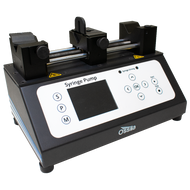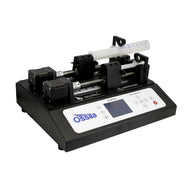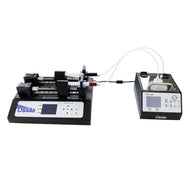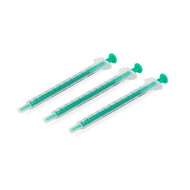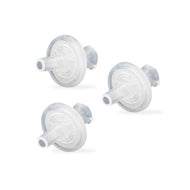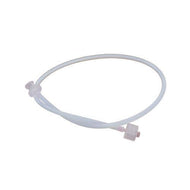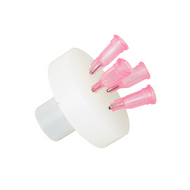Syringe Pump Accuracy and Precision
Syringe pumps provide precise control over the movement and delivery of fluids and can be incorporated into a wide range of experimental setups, ensuring that any work done is reproducible and accurate. Although syringe pumps can offer extremely fine control over the movement of the syringe, there are limitations associated with any measurement system. It is well known that the accuracy and precision of your measurement system is as good as your least accurate element. Therefore, it is important that you understand potential sources of error associated with syringe pumps.
To work out the accuracy and precision of either a hand-held syringe or a syringe pump, you must examine the properties and limitations of the system as well as the reproducibility of your repeat measurements.
Syringe Pumps

- High Quality
- Single and Dual Models
- Unbeatable Value
Prices from £1900
Limiting Factors for Syringe Pumps
Reproducibility
When referencing syringe pumps, we define reproducibility as the variation in a set deposition done by different users. In other words, reproducibility refers to how easy is it for one person to reproduce the same results as another person.
Research focusing on hand-held syringes shows how when different users measure the same volume, using the same syringe, there is a significant difference in accuracy and precision. We know that that user technique factors heavily into the accuracy and precision of hand-held syringes. However, there are also additional factors that affect this accuracy. These include: user fatigue, users' varying experience, and how regularly the user operate syringes.
The only way that you can negate user input is to automate the process entirely. To do this you can use systems such as the Ossila Syringe Pumps.
Errors in Syringe Diameter
We have put significant time and effort into the design and manufacture of the syringe pump. Therefore, the largest potential source of error actually lies in your choice of syringe. The volume and rate that your solution is delivered will be determined by the distance moved by the plunger and the cross-sectional area of the barrel. This specific cross-sectional area is dependant on the square of the barrel radius, so fluctuations in your syringe diameter will have a huge impact on the actual quantity of solution delivered. The most obvious error you can make with your automated syringe pump is to input an incorrect diameter into the software.
To negate this problem, some syringe pumps come with pre-set syringes of specified diameters. Within these systems, there is no need to define the syringe dimensions, so there is less room for error. However, these systems are quite limited as to the amount of solution you can accurately measure or deposit.
Other syringe pumps allow you to use whatever syringe is appropriate for your experiment. However, note that in these cases, you will need to input both the volume and the cross-sectional area of your syringe. You might assume that syringes with the same volume have the same diameter, but this is not always true. If you enter the wrong diameter of syringe, the syringe deposition rate will not be calculated correctly, and the volume of deposited solution will be higher or lower than you want. This will compromise the accuracy of your deposition rate. It is therefore important to measure internal diameter of the syringe (for example with callipers) and check this against the value used within the pump.

Variations in the diameter along the length syringes is another common source of error that you may encounter. During the manufacturing process of syringes, there are dimensional tolerances (AKA dimensional variations) which will vary due to the methods of manufacture and the materials chosen. For lower precision syringes (e.g. disposable plastic syringes), the diameter can vary by up to around 5%. This can result in a volume error of around 10%. For high precision glass or steel syringes, the diameter will typically vary between 1% and 2%. This causes between 2% to 4% volume error.
Minimum Dispense Volumes
The stepper motors that are used to move the syringe plunger in automated pumps can move the plunger head by tiny amounts. Due to the existence of microstepping techniques, the theoretical minimum dispense volume is calculated in nanolitres. There are, however, some practical limitations which limit this value quite significantly.
Most experimental setups which involve syringe pumps have some form of termination point, such as a tube or needle, where the solution exits. Errors in dispense volumes can often occur at this interface - between the termination point and the surroundings. To visualise this, we can use the example of a blunt needle surrounded by air.
If you dispense the solution slowly, it is not immediately transferred to the intended surface. Instead, the solution will form a droplet at the tip of the needle. This droplet will only break away from the needle tip when its volume exceeds a critical volume. Therefore, the minimum dispensable volume of solution to the experiment is effectively limited to the size of the droplet. If a low flow rate is maintained, the liquid will be deposited as a series of droplets rather than as a continuous flow of solution. Similarly, at the end of the dispense, a small volume of solution on the tip could remain on the tip, rather than being deposited into or onto the sample.
Syringe Limitation for Volumetric Measurements
The nominal volume of your syringe will affect the accuracy and precision of the volume that you measure. In order to ensure accurate and reproducible results, it is crucial that you select an appropriate syringe. A general rule to follow is that any volume measurement made using a syringe, must be at least 20% of the maximum syringe volume. However, some standard practises (especially for medical uses) recommend only using a syringe for volumes of over 50% its maximum volume. International standards for syringes state that the error value associated with measuring volumetric measurements under 50% of nominal syringe capacity (also known as Tolerance) should be:

For syringe volumes under 5ml and

For syringe volumes of over 5ml.
Ideally, you should try to choose a syringe so that the measured volume occupies the highest percentage of the nominal syringe volume. For example: if you need to measure 7ml of solution, you should do so using a 10ml syringe rather than a 20ml syringe. This will improve your precision and volume accuracy.
Research has also found that increasing the volume size of your syringe will also increase the accuracy and precision of your volume measurement. For example, measuring 1 ml volume in a 10 ml syringe will be a more exact measurement than measuring 0.1ml in a 1ml syringe. It makes sense that the smaller quantity of solution you are trying to measure, the harder it will be to measure accurately. Therefore, where possible, you should use larger quantities to improve the accuracy and precision of your measurements.

A final point to consider, especially when using an automated system like the syringe pump, is the dead space associated with both the syringe and the tubing. Dead space refers to liquid that you lose through blockage in the syringe spout or by adhesion to the tubing walls. The amount of solution that will be lost depends on the design of your syringe head, the length of your tubing and the viscosity and surface tension of your solution. This will likely be only a small amount compared to the solution quantity you are measuring. However, there are several measures you can take to reduce this loss.
These are:
- Avoid using excessively long tubing between the syringe pump and deposition point.
- Use syringes that are designed to reduce the amount of dead space in the head such as Norm-Ject Disposable Luer Lock Syringes.
- If necessary, you can try to reduce the viscosity/surface tension of your solution, by using alternate solvents or by diluting your solution.
References
- Jordan, M. A., Choksi, D., Lombard, K., & Patton, L. R. (2019). Development of guidelines for accurate measurement of small volume parenteral products using syringes. Hospital Pharmacy, 56(3), 165–171. DOI: 10.1177/0018578719873869
- Meyer, C. H., Liu, Z., Brinkmann, C., Rodrigues, E. B., & Helb, H.-M. (2011). Accuracy, precision and repeatability in preparing the intravitreal dose with a 1.0-cc syringe. Acta Ophthalmologica, 90(2). DOI: 10.1111/j.1755-3768.2010.02072.x
